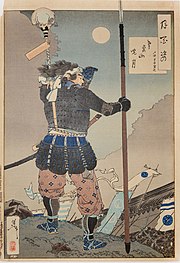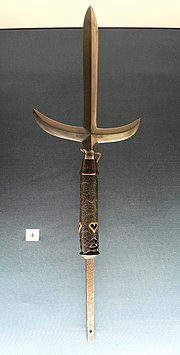
Three su yari mounted in koshirae, including one with an asymmetrical crossbar (hadome)
Yari (槍) is the term for one of the traditionally made Japanese blades (nihonto)[1][2] in the form of a spear, or more specifically, the straight-headed spear.[3] The martial art of wielding the yari is called sōjutsu.
History[]

Ukiyo-e print of a samurai general holding a yari in his right hand
Early yari are believed to have been derived from Chinese spears, these hoko yari are thought to be from the Nara period (710-794).,[4][5] and while they were present in early Japan's history, the term yari appeared for the first time in written sources in 1334 but this type of spear did not become popular until the late 1400s.[6] The original warfare of the bushi was not a thing for "commoners"; it was a ritualized combat usually between two warriors who would challenge each other via horseback archery.[7] However, the attempted Mongol invasions of Japan in 1274 and 1281 changed Japanese weaponry and warfare. The Mongol-employed Chinese and Korean footmen wielded long pikes, fought in tight formation, and moved in large units to stave off cavalry.[7] Polearms (including naginata and yari) were of much greater military use than swords, due to their much greater range, their lesser weight per unit length (though overall a polearm would be fairly hefty), and their great piercing ability.[7] Swords in a full battle situation were therefore relegated to emergency sidearm status from the Heian through the Muromachi periods.[7] Around the latter half of the sixteenth century, ashigaru holding pikes (nagae yari) with length of 4.5 to 6.5 m (15 to 20 feet) became the main forces in armies. They formed lines, combined with arquebusiers and short spearmen. Pikemen formed two or three row of line, and were forced to move their pikes in unison under command. Yari eventually became more popular than the yumi (bow) as a weapon for the samurai, and foot troops (ashigaru) used them extensively as well.[7] But by the Edo period the yari had fallen into disuse: with the greater emphasis on small-scale close quarters combat and the convenience of swords (as opposed to long battlefield weapons), polearms and archery lost their practical value. During the peaceful Edo era, yari were still produced, sometimes even by good sword smiths, they existed as a ceremonial weapon and a samurai police weapon for most of this era.
Description[]

Omi yari (large spear), Tokyo national museum.
Yari were characterized by a straight blade that could be anywhere from several centimeters, to 3 feet or more in length.[3] The blades were made of the same steel (tamahagane) that traditional Japanese swords and arrow heads were forged with, and were very durable.[3] Throughout history many variations of the straight yari blade were produced, often with protrusions on a central blade. Yari blades (points) often had an extremely long tang (nakago); typically the nagako would be longer than the sharpened portion of the blade. The nakago protruded into a re-enforced hollow portion of the handle (tachiuchi or tachiuke) resulting in a very stiff shaft making it nearly impossible for the blade to fall or break off.[3]
The shaft (nagaye or ebu) came in many different lengths, widths and shapes; made of hardwood and covered in lacquered bamboo strips, these came in oval, round, or polygonal cross section. These in turn were often wrapped in metal rings or wire (dogane), and affixed with a metal pommel (ishizuki) on the butt end. Yari shafts were often decorated with inlays of metal or semiprecious materials such as brass pins, lacquer, or flakes of pearl. A sheath (saya) was also part of a complete yari.[3]
Variations of yari blades[]

Straight Yari (su yari), detail view; blade is about 1 shaku (approx. 1 foot) in length

Jumonji yari blade with kuchigane (habaki) and Gyakuwa (collar), but otherwise unmounted; note the long tang, approx. equal to the blade-length
Various types of yari points or blades existed. The most common blade was a straight, flat, design that resembles a straight-bladed double edged dagger.[3] This type of blade could cut as well as stab and was sharpened like a razor edge. Though yari is a catchall for spear, it is usually distinguished between kama yari, which have additional horizontal blades, and simple su yari (choku-sō) or straight spears. Yari can also be distinguished by the types of blade cross section: the triangular sections were called sankaku yari and the diamond sections were called ryō-shinogi yari.[3]
- Sankaku yari (三角槍, triangle spear) have a point that resembles a narrow spike with a triangular cross-section. A sankaku yari therefore had no cutting edge, only a sharp point at the end. The sankaku yari was therefore best suited for penetrating armor, even armor made of metal, which a standard yari was not as suited to.[3] There are two types of sankaku yari, sei sankaku yari are yari blades that have a triangular cross section with three equal sides as in an equilateral triangle, and hira sankaku yari which have a triangular cross section with two equal sides like an isosceles triangle.
- Ryō-shinogi yari, a blade with a diamond shaped cross section.
- Fukuro yari (袋槍, bag spear or socket spear) were mounted to a shaft (nagaye or ebu) by means of a metal socket instead of a nakago (tang). The fukuro yari was forged as a single piece of both socket and blade.
- Kikuchi yari (菊池槍, spear of Kikuchi) were one of the rarest designs, possessing only a single edge. This created a weapon that could be used for hacking and closely resembled a tantō. kikuchi yari are the only yari which use a habaki .
- Yajiri nari yari (鏃形槍, spade-shaped spear) had a very broad "spade-shaped" head. It often had a pair of holes centering the two ovoid halves.
- Jūmonji yari (十文字槍), cross-shaped spear, also called magari yari (曲槍, curved spear), looked something similar to a trident or partisan and brandished a pair of curved blades around its central lance. Occasionally called maga yari in modern weaponry texts.
- Kama yari (鎌槍, sickle spear) gets its name from a peasant weapon called kama (lit. sickle or scythe). However, a kama isn't a scythe as most Westerners think of it, a giant, curved blade connected at right angles to a two-meter-long wooden handle, but rather a much smaller version, with a less dramatically curved blade and a straight wooden handle approximately two feet long.[3]
- Kata kama yari (片鎌槍, single-sided sickle spear) had a radical weapon design sporting a blade that was two-pronged. Instead of being constructed like a military fork, a straight blade (as in su yari) was intersected just below its midsection by a perpendicular blade. This blade was slightly shorter than the primary, had curved tips making a parallelogram, and was set off center so that only 1/6 of its length extended on the other side. This formed a kind of messy 'L' shape.
- Tsuki nari yari (月形槍, moon-shaped spear) barely looked like a 'spear' at all. A polearm that had a crescent blade for a head, this could be used for slashing and hooking.
- Kagi yari (鉤槍, hook spear) had a long blade with a side hook much like that found on a fauchard. This could be used to catch another weapon, or even dismount a rider on horseback.
- Bishamon yari possessed some of the most ornate designs for any spear. Running parallel to the long central blade were two 'crescent moon' shaped blades facing outwards. They were attached in two locations by short cross bars, making the head look somewhat like a fleur-de-lis.
- Hoko yari An old form of yari possibly from the Nara period (710-794),[8] a guard's spear with six-foot pole and eight inch blade either leaf-shape or waved (like the Malay kris) ; a sickle-shaped horn projected on one or both sides at the joint of blade.[9] The hoko yari had a hollow socket like the later period fukuro yari for the pole to fit into rather than a long tang.
- Sasaho yari A broad yari that is described as being "leaf shaped" or "bamboo leaf shaped".[11]
- Su yari (sugu yari), a straight double edged blade.[12]
- Omi no yari (omi yari), an extra long su yari blade.[12]
Variations of yari shafts (nagaye or ebu)[]
A yari shaft can range in length from one meter to upwards of six meters (3.3 to 20 feet).
- Mochi yari (hand spear), a long spear used by ashigaru and samurai.[15]
- Kuda yari (管槍, tube spear). The shaft (nagaye or ebu) of the kuda yari goes through a hollow metal tube that allowed the kuda yari to be twisted while being thrust. This style of sojutsu is typified in the school Owari Kan Ryū.
- Makura Yari (pillow spear). A yari with a short simple shaft (nagaye or ebu) that was kept by the bedside for home protection.[16]
- Te yari (hand spear). A yari with a short shaft (nagaye or ebu) that was used by samurai police to help capture criminals.[17]
Gallery[]
See also[]
References[]
- ↑ The Development of Controversies: From the Early Modern Period to Online Discussion Forums, Volume 91 of Linguistic Insights. Studies in Language and Communication, Author Manouchehr Moshtagh Khorasani, Publisher Peter Lang, 2008, ISBN 3-03911-711-4, ISBN 978-3-03911-711-6 P.150
- ↑ The Complete Idiot's Guide to World Mythology, Complete Idiot's Guides, Authors Evans Lansing Smith, Nathan Robert Brown, Publisher Penguin, 2008, ISBN 1-59257-764-4, ISBN 978-1-59257-764-4 P.144
- ↑ 3.0 3.1 3.2 3.3 3.4 3.5 3.6 3.7 3.8 Ratti, Oscar; Adele Westbrook (1991). Secrets of the Samurai: The Martial Arts of Feudal Japan. Tuttle Publishing. pp. 484. ISBN 978-0-8048-1684-7.
- ↑ Japan and China: Japan, its history, arts, and literature, Frank Brinkley, T. C. & E. C. Jack, 1903 p.156
- ↑ The connoisseur's book of Japanese swords, Kōkan Nagayama, Kodansha International, p.49
- ↑ Friday, Karl (2004). Samurai, Warfare and The State in Early Medieval Japan. Routledge. p. 87. ISBN 0-415-32962-0.
- ↑ 7.0 7.1 7.2 7.3 7.4 Deal, William E (2007). Handbook to Life in Medieval and Early Modern Japan. Oxford University Press. pp. 432. ISBN 978-0-19-533126-4.
- ↑ The new generation of Japanese swordsmiths, Tamio Tsuchiko, Kenji Mishina, Kodansha International, 2002 p.15
- ↑ The Encyclopedia Americana: a library of universal knowledge, Volume 15 Encyclopedia Americana Corp., 1919 p.745
- ↑ The Japanese sword Kanzan Satō, Kodansha International, 1983 P.63
- ↑ The connoisseur's book of Japanese swords, Kōkan Nagayama, Kodansha International, 1998 p.49
- ↑ 12.0 12.1 The connoisseur's book of Japanese swords, Kōkan Nagayama, Kodansha International, 1998, P.49
- ↑ Fighting techniques of the Oriental world, AD 1200-1860: equipment, combat skills, and tactics Fighting Techniques, Authors Michael E. Haskew, Christer Joregensen, Eric Niderost, Chris McNab, Publisher Macmillan, 2008, ISBN 0-312-38696-6, ISBN 978-0-312-38696-2 P.44
- ↑ Ashigaru 1467-1649, Stephen Turnbull, Howard Gerrard, Osprey Publishing, 2001, P.19
- ↑ Ashigaru 1467-1649, Authors Stephen Turnbull, Howard Gerrard, Illustrated by Howard Gerrard, Publisher Osprey Publishing, 2001, ISBN 1-84176-149-4, ISBN 978-1-84176-149-7 P.23
- ↑ 'Samurai:The Weapons and Spirit of the Japanese Warrior', Author Clive Sinclaire, Publisher Globe Pequot, 2004, ISBN 1-59228-720-4, ISBN 978-1-59228-720-8P.119
- ↑ Taiho-jutsu: law and order in the age of the samurai, Author, Don Cunningham, Publisher Tuttle Publishing, 2004, ISBN 0-8048-3536-5, ISBN 978-0-8048-3536-7 P.44
External links[]
| Wikimedia Commons has media related to Yari. |
| |||||||||||||||||||||||||||||||||||||||||||||||
The original article can be found at Yari and the edit history here.




